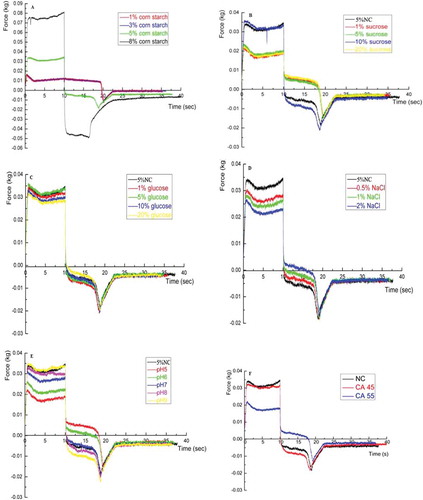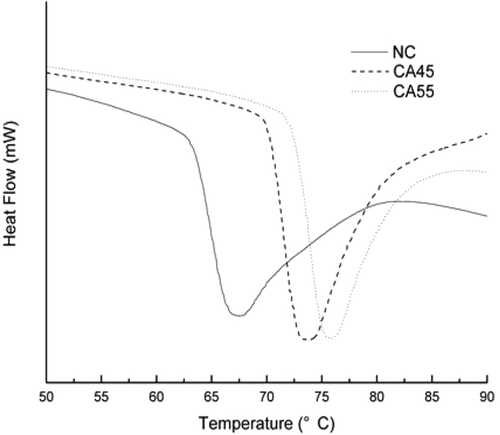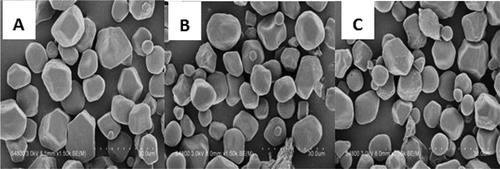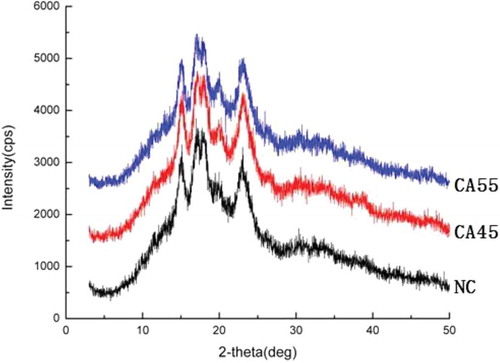 ?Mathematical formulae have been encoded as MathML and are displayed in this HTML version using MathJax in order to improve their display. Uncheck the box to turn MathJax off. This feature requires Javascript. Click on a formula to zoom.
?Mathematical formulae have been encoded as MathML and are displayed in this HTML version using MathJax in order to improve their display. Uncheck the box to turn MathJax off. This feature requires Javascript. Click on a formula to zoom.Abstract
The effects of additives (sucrose, glucose, and sodium chloride) on textural properties of native and annealed corn starch gels were measured using differential scanning calorimetry, X-ray diffraction, scanning electron microscopy, and texture analyzer. Annealing temperature, additive concentration, and pH affected the corn starch gels. Firmness, consistency, cohesiveness, and viscosity values ranged from 20.55 to 43.70 g, 213.67 to 412.00 g/sec, –25.81 to –15.22 g, and –104.21 to –6.73 g/sec, respectively. The eigenvalue of the texture characteristics of annealed corn starch decreased without additives, and increased with additives. Annealing at 55°C had more effect than did annealing at 45°C.
Introduction
Plant starches gelatinize when starches are heated in excess water, caused an order–disorder phase transition. During the gelatinization, water diffuses into the starch granules, causing hydration and swelling of the starch granules, loss of crystalline, and amylose leaching.[Citation1] As a result, swollen granules are wrapped by the entangled amylose molecules. The complex molecules are described as a viscoelastic gel when cooling, a phenomenon described as “gelation.” The amylose gel network remains unchanged and gelation of amylopectin within the swollen granules develops slowly during storage, leading to increased gel structure.[Citation2] The reverse of this is starch retrogradation, which in mung bean starch has been shown to be affected by many factors, such as storage temperature, sugar, and starch concentrations, the presence of lipids and salts, and chemical or physical modifications.[Citation3]
Annealing is a physical process that has been used for centuries to modify the desirable properties of materials, from metals and plastics to biopolymers such as nucleic acids and starches. Annealing starch with excess water (>40%, w/w) at temperatures that are below gelatinization temperature and above glass transition temperature for a certain period of time[Citation4] results in obvious changes in gelatinization characteristics, such as the size, amylose content and swelling power of starches, and makes the starch crystalline structures perfect.[Citation5,Citation6]
However, starches have a wide range of rheological properties, as their state can range from a simple viscous fluid to strong elastic gel. The formation of a plant starch gel depends, in part, on the ratio of amylose to amylopectin and the arrangements of these polymers within the granules, both of which are characteristic and unique to each plant product.[Citation7] These structures are unstable, with the removal of chain segments increasing the mobility of starch molecules and affecting the firmness, consistency, cohesiveness, and other characteristics of the starch gels. The textural characteristics of a starch gel impact its taste and its functional performance, which then determine the range of starch usefulness.[Citation8]
The pasting property of starch is one of the important properties and is usually evaluated in the manufacturing process of most flour products. The textural characteristics of a starch gel, once evaluated, are used to improve the quality of flour-containing foods. The key textural characteristic of corn starch involves the re-association of starch molecules during gelling. The amylose of corn starch easily leaches out, leading to the separation of amylose and amylopectin. Lipid components within corn starch allow for the segregation of amylose, which can then form complexes with additives.[Citation9,Citation10] The use of corn starch in food products affects the gelling characteristics and processing quality of flour-containing foods through the interaction of its leached amylose with additives in the food product.[Citation11] Therefore, this study focuses not only on the modification of corn starch through annealing, but also on the mutual influences of annealing and the addition of sucrose, glucose and/or salt on the textural characteristics of firmness, consistency, cohesiveness, and viscosity of corn starch gels.
Materials and methods
Materials
Native corn starch (NC) was purchased from Sigma Co. (St. Louis, MO, USA). CA45 and CA55 was that 90% moisture corn starch annealed at 45 and 55°C for 72 h, respectively. Biochemical grade sodium azide was purchased from Sinopharm Chemical Reagent Co. (SCRC, Shanghai, China). All other reagents used were of analytical grade from SCRC.
Methods
Preparation of annealed corn starch
NC starch was annealed by a single-step process.[Citation12] Starch (3 g) and 27 mL of distilled water were placed in a centrifuge tube (moisture content approximately 90% by weight) and incubated at either 45 or 55°C for 72 h. These conditions were chosen according to the results of Tester,[Citation12] and the annealing effect was obvious under these conditions. Sodium azide was added as a bacteriostatic agent. After the annealing treatment, all starch samples were centrifuged and washed three times with acetone, ethyl alcohol and distilled water, successively. Samples were then collected by suction filtration using a Hirsch funnel and dried at room temperature.
Concentrations of corn starch and additives
Corn starch was prepared at different concentrations of starch suspensions (1, 3, 5, 8% [w/v]). The additives (sucrose, glucose and sodium chloride [NaCl]) were completely dissolved in distilled water at concentrations of (1, 5, 10, 20% [w/v]); (1, 5, 10, 20% [w/v]); (0.5, 1, 2% [w/v]), respectively.
Differential scanning calorimeter (DSC)
Starch samples were weighed and placed in 5 mL screw-top Sovirel tubes, to which distilled water was added in order to prepare a 20% starch slurry. About 7–10 mg of the prepared samples were added to an aluminum pan and immediately sealed. The sealed aluminum pans were reweighed and were equilibrated overnight at room temperature before DSC analysis. An empty pan was used as a reference. The sealed aluminum pans were heated from 0 to 100°C at a heating rate of 10°C/min. Gelling onset temperature (TO), peak temperature (TP), and conclusion temperature (TC) were measured during heating in the DSC2000 (TA, America). The enthalpy (ΔH, J/g) for gelatinization was calculated automatically with the TA Instruments “Universal Analysis 2000” software program.[Citation13] Each experiment was conducted in either duplicate or triplicate.
Scanning electron microscopy (SEM)
Dry starch granules were sprinkled into a thin layer on double-sided adhesive tape attached to specimen stubs and coated with gold-palladium twice (50 s each time). Granule morphology of each sample was examined using a FEI Sirion 200 SEM[Citation14] at 3 kV accelerating voltage.
X-ray diffraction (XRD)
Dry starch samples were ground into powder by mortar and pestle and passed through a 200 mesh sieve. XRD patterns of starch samples were obtained by a Rigaku TTR-III X-ray diffractometer with a copper target. The diffractometer was operated at 40 kV and 200 mA, with a reflection angle (2θ) from 3° to 50° at a 0.02° step size with the speed of 8°/min.[Citation15] The crystallinity (%) was calculated as follows:[Citation16]
where Ac is crystalline area on the X-ray diffractogram, and Aa is amorphous area on the X-ray diffractogram.
Texture analyzer (TA)
Starch samples were weighed (dry basis) and placed in a 250 mL beaker, to which distilled water was added in order to prepare 5% starch suspensions. Different concentrations of the additives (sucrose, glucose, and sodium chloride [NaCl]) were completely dissolved in distilled water and added to the 5% (w/v) starch suspensions.[Citation17] The pH of each starch suspension was adjusted with dilute hydrochloric acid or sodium hydroxide solution using a pH meter. The starch-additive suspensions were heated in a water bath for 20 min at a constant temperature (90°C) with moderate mechanical agitation and then cooled to room temperature (approximately 20°C).
Textural properties of the starch gels were determined with a TA.XT Plus TA with a Back Extrusion (A/BE) RIG 45 mm detector. Pre-test speed, test speed, post-test speed, distance and trigger force were 1.5, 2.0, 2.0, 20.0, and 5.0 g, respectively. The trigger type was an auto-test with three repeats. The texture parameters of this system have been measured at room temperature.
Statistical Analyses
All the experiments were replicated three times and the results were reported as the mean combined with standard derivation. Analysis of variance (one-way ANOVA) was performed.
Results and discussion
Gelatinization Characteristics by DSC
Previous DSC analysis[Citation18] showed that the temperature at which annealing began (To) increased a little as the temperature at which the starch samples were annealed rose between 25 and 45°C, but that a significant linear growth in To occurred between 45 and 65°C. Therefore, annealing temperatures for these assays were selected at 45 and 55°C.
The effects of annealing on gelatinization characteristics are shown in . Annealing at 55°C (CA55) increased the To, TP, and TC values and decreased the gelatinization range (Tc–To) and gelatinization enthalpy (ΔH) compared to both un-annealed native cornstarch (NC) and annealing at 45°C (CA45). These changes have been attributed to the perfection of pre-existing crystallites[Citation19] For both annealing temperatures, the magnitude of the change in temperature for each part of the gelling reaction (with respect to NC starch) ranked To > TP > Tc. This corresponded to temperature changes of 1.31 > 0.67 > –0.31°C for CA45 and of 7.96 > 6.26 > 3.55°C for CA55. The ΔT (Tc–To) was significantly reduced from 8.38 to 6.76°C for CA 45 and to 3.91°C for CA 55. Annealing had a great effect on To, probably because To represents the melting of the weakest crystallites. These weak crystallites are more likely to become bonded through annealing than crystallites of higher initial stability. DSC thermograms () visibly show this change in gelatinization characteristics due to temperature annealing.
TABLE 1 Gelatinization characteristics of native and annealed corn starches
Microscopic Granule Morphology by SEM
SEM was used to observe the shape and surface characteristics of native and annealed corn starch. There is a dearth of information on the effects of annealing on the starch morphology at the micron scale, although several authors have produced annealed wheat, oat, lentil, barley, and potato starches without any observable changes in granule morphology.[Citation20] However, Wang et al. suggested that annealing might create cracks or pores in the starch particles.[Citation21] Annealed starches from certain barley cultivars have been shown to develop large pores, while in other barley cultivars the pore size increases only slightly.[Citation22] Micrograph images of NC, CA45, and CA55 at a magnification of 1500× () showed that both the overall shape and surface morphology of the starch granules were similar with () or without ( and ) annealing.
Crystal Morphology by XRD
The XRD patterns of native and annealed corn starches showed that the crystalline structure of all the corn starch samples followed an A-type diffraction pattern, with main peaks at 15, 17, 18, and 23°.[Citation23] However, annealing of corn starch increased the relative crystallinity of CA45 (up by 0.17%) and of CA55 (up by 0.85%) over the NC (). The increase in relative crystallinity may be the result of an increase in the order of the crystalline structures, an increase in the sizes of the crystals, a reorientation of the crystals, and/or the formation of new crystallites from previously unassociated starch chains. Additionally, the formation of a double helix structure between amylose and amylopectin may have caused the differences in crystal morphology between NC, CA45, and CA55.
Textural Characteristics by TA
The eigenvalues of the textural characteristics of firmness (maximum peak forward force), consistency (calculated as the area of the positive peak), cohesiveness (maximum peak inverse adhesive), and index of viscosity (the area of the negative peak) were measured for the corn starch gels. In the force-time texture plots, the force value and area of the positive peak become greater with an increase in the cohesion and resistance of the starch gel. The negative force values show the adhesion ability of the gel and probe. The greater the absolute value of the adhesion, the more viscous and sticky the gel.
Different concentrations of NC gels (1, 3, 5, 8%) were analyzed using texture analysis (TA; ). Firmness and cohesiveness, as reflected in the higher forces withstood by the gel, increased with an increase in the starch concentration (). Increased firmness and cohesiveness may result from the parallel orientation of a segment of the linear chain of the amylose molecules when the starch is at higher concentration. In addition, the amount of leached amylose may increase with increased starch concentration. Since the form of the starch gel has been shown to be closely linked to retrogradation of the leached amylose during cooling,[Citation3] gel properties are related to the concentration of the starch suspension.
FIGURE 4 (A) Textural characteristics of different concentrations of NC gels; (B) Textural characteristics of NC gels with different concentrations of sucrose; (C) Textural characteristics of NC gels with different concentrations of glucose; (D) Textural characteristics of NC gels with different concentrations of NaCl; (E) Textural characteristics of NC gels with different pH; (F) Textural characteristics of NC, CA45 and CA55 gels without additives.

For the following experiments, a 5% NC suspension was employed for the testing of different concentrations of additives. Different concentrations of sucrose significantly changed the gel properties of the NC gels (, ). Addition of 1% sucrose reduced the textural characteristic values of NC gels, but 10% sucrose led to a slight increase of the four values. Addition of glucose (1–20%) only caused slight changes in the four parameters in the NC gels (, ). Decreases in gel strength from the addition of sugars at lower concentrations (1% sucrose) may be due to the attenuation of the embedded molecular chains, as the sugar forms a hydration layer, which may delay the association of starch molecules. High concentrations (10% sucrose, 5% glucose) of sugar would reduce the water activity of the system, while the interaction of sugar with starch chains made the embedded molecular chains more stable, which increased the texture characteristic of the starch gel.[Citation24–Citation26] Based on these results, 5% glucose was used for further tests.
The concentration of sodium chloride was optimized. As the sodium chloride concentration increased, the textural characteristics decreased (). The dissociation of the Na+ and Clˉ ions in the water affects the interactions between the water molecules and starch molecules, hindering the gelatinization process and reducing the viscosity.[Citation27] The greatest effect on the textural characteristics was from addition of 2% sodium chloride.
Alteration of solution pH had substantial effects on the firmness and consistency of the NC gel. Acidic and neutral conditions significantly lowered these parameters, whereas alkaline condition resulted in characteristics similar to those of NC without additives, which had a pH of ~~ (). One previous study stated that strongly acidic and alkaline conditions decreased the aging rate of the gelatinized starch, decreased the sizes of the starch molecules, and slowed down molecular rearrangement relative to neutral conditions and that pH primarily affected the ionization of the hydroxyl groups on the glucose residues.[Citation26] At pH 5, there was strong dissociation of the glucose molecules in the amylose, causing a reduction in textural properties. At pH 9, OHˉ ions destroyed the hydrogen bonds between starch molecules, thus changing the textural properties.
Based on the preliminary studies with NC (), additive concentrations were selected for producing annealed corn starch mixtures for texture analysis (). First, the textural characteristics of NC, CA45, and CA55 gels without additives () were compared. Annealing at 55°C significantly lowered the corn starch textural characteristics of firmness, consistency, and viscosity. Previous studies found that the swelling power of corn starch increased with annealing and that the rigidity of starch granules is inversely proportional to the swelling degree of granules.[Citation28] Therefore, annealed starch has lower rigidity than native starch, leading to reduced surface hardness (a textural characteristic) in the starch. CA45 exhibited increased, rather than reduced, viscosity. This was attributable to the effects of leached amylose.
TABLE 2 Experimental conditions for texture comparison between native and annealed corn starches
Textural analysis was carried out comparing annealed starches (CA45 and CA55) and NC with and without additives (). Addition of 1 or 10% sucrose resulted in a larger increase in the four parameters for the CA55 samples than for the CA45 samples. Addition of 5% glucose to CA45 produced a significant decrease in firmness and consistency, but had the opposite effect on CA55. The addition of 2% sodium chloride in both CA45 and CA55 resulted in an obvious increase in the four parameters, especially in the CA45. This was opposite to what happened to NC with 2% sodium chloride. The effect of pH was different between the CA45 and CA55 samples. Under basic conditions, CA45 was much less firm and CA55 was less firm than NC. However, CA55 under acidic condition was much firmer than both NC and CA45. Both CA45 and CA55 had greater consistency under acidic condition, but NC was more firm under basic condition. The interplay between annealing and high or low pH requires a case-by-case investigation when comparing to both unaltered and pH-influenced NC.
TABLE 3 Texture characteristics of native and annealed starches with different additives and solution pH
For most of the additives, the interplay with annealing (at either one of or both temperatures) resulted in an opposite effect on the gel properties when compared to the additive with unannealed NC. Gel properties are influenced by both the leached-out amylose and the rigidity of the swollen granules, but these two factors are changed by both annealing and the different additives.[Citation3] Annealing has been found to increase crystalline perfection and to optimize the links between glucose residues, leading to strong dissociation. This can happen under strongly acidic or alkaline conditions.
Conclusions
Annealed corn starch exhibited an A-type X-ray pattern typical of cereal starches. Annealing had no effect on the visual granule morphology of corn starch. Corn starch annealed at 45°C had slightly increased textural properties relative to NC, while corn starch annealed at 55°C had decreased textural properties. Additives had different effects on textural characteristics of the annealed or NC starch gels. The NC gel showed decreased gel strength when mixed with a low concentration of sugar or 2% sodium chloride or under acidic environment, but increased gel strength with high sugar concentration and under alkaline condition. The effects of additives on the textural characteristics of annealed gels were distinctly different. Overall, the strength of CA55 was increased with additives. The strength of the CA45 only increased with addition of 10% sucrose or 2% sodium chloride. In conclusion, annealed and NC starches differed in their textural properties both with and without additives, and annealing at 55°C had a more pronounced effect than annealing at 45°C on the textural properties.
Funding
We thank the National Natural Science Foundation of China (NSFC 31171655, NSFC 31371735) for financial support.
Additional information
Funding
References
- Hoover, R. Starch Retrogradation. Food Reviews International 1995, 11, 331–346.
- Russell, P.L. The Ageing of Gels from Starches of Different Amylose/Amylopection Content Studied by Differential Scanning Calorimetry. Journal of Cereal Science 1987, 6, 147–158.
- Koo, M.C.; Tae, W.M.; Jae, K.C. Influence of Annealing on Gel Properties of Mung Bean Starch. Cereal Chemistry 2000, 77, 567–571.
- Tester, R.F.; Debon, S.J.J.; Annealing of Starch—A Review. International Journal of Biological Macromolecules 2000, 27, 1–12.
- Jayakody, L.; Hoover, R.; Effect of Annealing on the Molecular Structure and Physicochemical Properties of Starches from Different Botanical Origins—A Review. Carbohydrate Polymers 2008, 74, 691–703.
- Gomes, A.M.M.; Silva, C.E.M.; Ricardo, N.M.P.S. Effects of Annealing on the Physicochemical Properties of Fermented Cassava Starch (Polvilho Azedo). Carbohydrate Polymers 2005, 60, 1–6.
- Thitipraphunkul, K.; Uttapap, D.; Piyachonkwan, K.; Takada, Y. A Comparative Study of Edible Canna (Canna Edulis) Starch from Different Cultivars. Part II. Molecular Structure of Amylose and Amylopectin. Carbohydrate Polymers 2003, 54, 489–498.
- Mua, J.P.; Jackson, D.S. Relationships Between Functional Attributes and Molecular Structures of Amylose and Amylopectin Fractions from Corn Starch. Journal Agriculture and Food Chemistry 1997, 45, 3848–3854.
- Wang, L.Z.; White, P.J. Structure and Physicochemical Properties of Starches from Oats with Different Lipid Content. Cereal Chemistry 1994, 71, 443–450.
- Zhang, Y.P. In Modified Starch Manufacturing and Application; Chemical Industry Press: Beijing, China, 2007; 64–70 pp.
- Li, J.Y.; Michael, O.N. Textural and Other Quality Properties of Instant Fried Noodles As Affected by Some Ingredients. Cereal Chemistry 2004, 81, 772–776.
- Tester, R.F.; Debon, S.J.J.; Sommerville, M.D.; Annealing of Maize Starch. Carbohydrate Polymers 2000, 42, 287–299.
- Kaoru, K.; Tomoko, S. Differential Scanning Calorimetry and a Model Calculation of Starches Annealed at 20 and 50°C. Carbohydrate Polymers 2006, 63, 82–88.
- Adebowale, K.O.; Henle, T.; Schwarzenbolz, U.; Doert, T.; Modification and Properties of African Yam Bean (Sphenostylis Stenocarpa Hochst. Ex A. Rich.) Harms Starch I: Heat Moisture Treatments and Annealing. Food Hydrocolloids 2009, 72, 1947–1957.
- Manzocco, L.; Nicoli, M.C.; Labuza, T.P. Study of Bread Staling by X-Ray Diffraction Analysis. Italian Journal of Food Science 2002, 14, 235–249.
- Du, X.F.; Macnauhtan, B. Quantification of Amorphous Content in Starch Granules. Food Chemistry 2011, 127, 188–191.
- Baker, L.A.; Duarte, P.R. Freeze-Thaw Stability of Amaranth Starch and Effects of Salt and Sugars. Cereal Chemistry 1998, 75, 301–307.
- Kuntson, C.A. Annealing of Maize Starches at Elevated Temperatures. Cereal Chemistry 1990, 467, 376–384.
- Jayakody, L.; Hoover, R.; Liu, Q.; Donner, E. Studies on Tuber Starches III. Impact of Annealing on the Molecular Structure, Composition, and Physicochemical Properties of Yam (Dioscorea sp.) Starches Grown in Sri Lanka. Carbohydrate Polymers 2009, 76, 145–153.
- Jayakody, L.; Hoover, R. Effect of Annealing on the Molecular Structure and Physicochemical Properties of Starches from Different Botanical Origins—A Review. Carbohydrate Polymers 2008, 74, 691–703.
- Wang, W.J.; Powell, A.D.; Oates, C.G. Effect of Annealing on the Hydrolysis of Sago Starch Granules. Carbohydrate Polymers 1997, 33, 195–202.
- Liu, H.S.; Yu, L.; Simon, G.; Dean, K.; Chen, L. Effects of Annealing on Gelatinization and Microstructures of Corn Starches with Different Amylose/Amylopectin Ratios. Carbohydrate Polymers 2009, 77, 662–669.
- Lan, H.; Hoover, R.; Jayakody, L.; Liu, Q.; Donner, E.; Baga, M.; Asare, E.K.; Hucl, P.; Chibbar, R.N. Impact of Annealing on the Molecular Structure and Physicochemical Properties of Normal, Waxy, and High Amylose Bread Wheat Starches. Food Chemistry 2008, 111, 663–675.
- Sumnu, G.; Ndife, M.K. Effects of Sugar, Protein, and Water Content on Wheat Starch Gelatinization Due to Microwave Heating. Springer-Verlag 1999, 209, 68–71.
- Torley, P.J.; van der Molen, F. Gelatinization of Starch in Mixed Sugar Systems. Swiss Society of Food Science and Technology 2005, 38, 762–771.
- Zhang, X.; Qunyi, T.; Zhu W.X.; Fei, R. Pasting, Rheological Properties, and Gelatinization Kinetics of Tapioca Starch with Sucrose or Glucose. Journal of Food Engineering 2013, 114, 255–261.
- Guo, L.; Du, X.F. Retrogradation Kinetics and Glass Transition Temperatures of Pueraria Lobata Starch, and Its Mixtures with Sugars and Salt. Starch–Starke 2014, 66, 887–894.
- Lii, C.; Tsai, M.; Tseng, K. Effect of Amylose Content on the Rheological Property of Rice Starch. Cereal Chemistry 1996, 73, 415–420.



